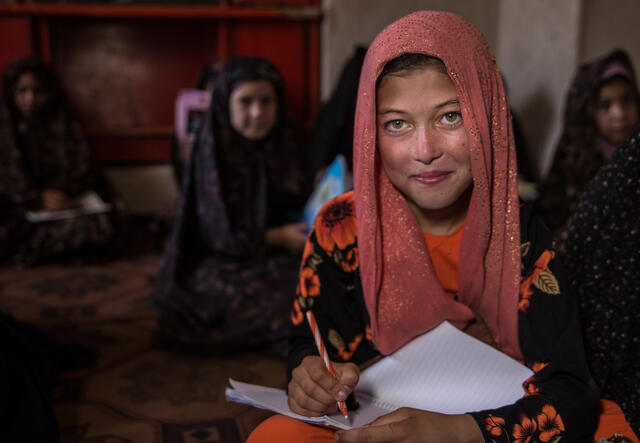What is happening to women and girls in Afghanistan?
Here’s a look at what women and girls in Afghanistan need right now and what can be done to help.
Here’s a look at what women and girls in Afghanistan need right now and what can be done to help.
The recent transfer of power from the former Afghan government has caused immense uncertainty across Afghanistan.
Even before the latest developments, half the population required humanitarian assistance. Forty years of war, chronic poverty, climate change-driven natural disasters, and now COVID-19 are a deadly combination for people in Afghanistan. Seventy-five percent of those in need are women and children.
World leaders must not forget the urgent needs of Afghan women and girls. The world cannot afford to turn its back. Here’s a look at what women and girls in Afghanistan need right now and what can be done to help.
Update: On December 20, 2022, universities in Afghanistan were closed to women and girls, a chilling step backward for the country. Get the latest.
The International Rescue Committee (IRC) is particularly concerned about the situation in Afghanistan for women and girls. Women’s rights must be respected. Critical services for women and girls must continue to be delivered, and this requires female aid workers who are able to access communities and create safe spaces for women and girls. Women must be allowed to work and to move freely, and girls must be allowed to continue to go to school.

Women and children are increasingly bearing the brunt of the violence and make up around half of all civilian casualties. They continue to be at risk of targeted attacks. Afghanistan has been the deadliest place for children for the past six years.
Women in Afghanistan face rising levels of domestic violence, abuse and exploitation.
“We know that during times of crisis, violence against women and girls increases," says Elinor Raikes, IRC vice president and head of program delivery. "With uncertainty mounting throughout Afghanistan, the IRC is concerned that we could see an increase in violence against women as well as an increase in child marriage."
We know that during times of crisis, violence against women and girls increases.
World leaders must fill the wide gap in aid funding so that women and children can receive protection and meet their essential needs.
As of August 2021, the international humanitarian response plan for Afghanistan is only 64 percent funded. That shortfall could mean that 1.2 million children will lose specialized protection services, making them more vulnerable to violence, recruitment, child labor, early and forced marriages, and sexual exploitation. And 1.4 million women—many of them survivors of violence—will be left without safe places to receive comprehensive support.
Across the world, women frequently eat least, last and least well within their households, and suffer the most from nutrient deficiencies. In Afghanistan, women are struggling to feed their families as the country faces an emergency hunger crisis. Farmers haven’t recovered from a drought in 2018, while the coming year is projected to be worse. International donors have suspended aid to the country and the economy is collapsing.
Twenty-three million Afghans are on the brink of famine, and one million children are at risk of dying without immediate lifesaving treatment.
Nearly all clients who have attended IRC-run health clinics in recent weeks have been women bringing malnourished children for urgent help. Twenty-three million Afghans are on the brink of famine, and one million children are at risk of dying without immediate lifesaving treatment.
Over the past 20 years, progress has been made on the number of girls receiving an education in Afghanistan, but over the past few months attacks on schools and villages dramatically increased while international support has slowly withdrawn. It is feared that 1 million children will miss out on education.
In July, we spoke with a group of Afghan schoolgirls who shared their fears with us. "As the fighting increases day by day, it's a concern that we'll go back in time," one 15 year old said.
Humanitarian organizations like the IRC have stayed in Afghanistan through crisis after crisis, and we will stay and deliver now.
“If our teams are to reach women and girls within communities, the role of women aid workers is critical," says Elinor Raikes. "Without women working in the humanitarian response in Afghanistan, aid organizations are unable to create safe spaces where the needs of women and girls can be met."
If our teams are to reach women and girls within communities, the role of women aid workers is critical.
"It is absolutely crucial that the international community, including the United States, UK and European Union, recognize this and push for unfettered humanitarian access and ensure that all aid workers, including female staff at all levels of management, can safely operate across the country.”
How the IRC helps in Afghanistan
The IRC began responding in Afghanistan in 1988, and now works in thousands of villages across nine provinces, with Afghans making up more than 99 percent of IRC staff in the country.

We support displaced families with shelter, clean water and sanitation, and other necessities. We provide cash assistance and help people find livelihood opportunities. And we create safe learning spaces and offer community-based education, among other support.
How you can help
Learn more about the IRC’s response in Afghanistan and donate now to help the IRC support Afghans in crisis.
Afghanistan crisis: Learn more
Crisis information: Afghanistan facts l What is happening in Afghanistan? l Crisis outlook
In focus: Hunger crisis l Climate change impacts l How Afghan allies seek safety l Afghan Special Immigrant Visa (SIV)How the IRC helps Afghans:In Afghanistan l In the U.S. l Around the globe
How to help Afghans: In Afghanistan l In your community l Donate to the IRC